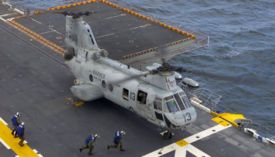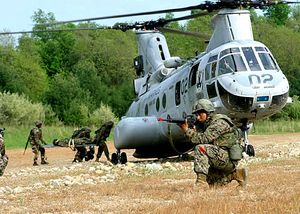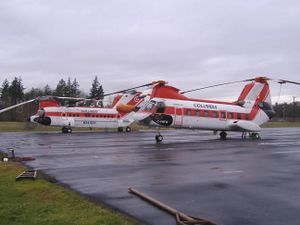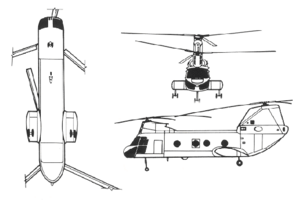PlaneSpottingWorld welcomes all new members! Please gives your ideas at the Terminal.
CH-46 Sea Knight
| CH-46 Sea Knight | |
|---|---|
| Sailors from USS Saipan rush out to unchain a CH-46 Sea Knight, April 2004. | |
| Type | Cargo helicopter |
| Manufacturer | Vertol Aircraft Corp. Boeing Vertol |
| Maiden flight | August 1962 |
| Retired | 2004-09-04 (USN) Planned 2014 (USMC) |
| Status | Active service |
| Primary users | United States Marine Corps Japan Saudi Arabia Sweden |
| Produced | 1962–1971 |
| Number built | 600+ |
| Variants | CH-113 Labrador |
The Boeing CH-46 Sea Knight is a medium-lift tandem rotor cargo helicopter, used by the United States Marine Corps (USMC) to provide all-weather, day-or-night assault transport of combat troops, supplies and equipment. Assault Support is its primary function, and the movement of supplies and equipment is secondary. Additional tasks include combat support, search and rescue, support for forward refueling and rearming points, casualty evacuation and Tactical Recovery of Aircraft and Personnel (TRAP). The commercial version is the BV 107-II, commonly referred to as simply the "Vertol".
Contents
Design and development
Piasecki was a pioneering developer of tandem-rotor helicopters, with the most famous previous helicopter being the H-21 "Flying Banana". Piasecki's former company Vertol began work on a new tandem rotor helicopter designated the Vertol Model 107 or V-107 in 1957. The V-107 had two Lycoming T53 turboshaft engines, producing 860 shp (640 kW) each.[1] The first flight of the V-107 took place on April 22, 1958. The V-107 was then put through a flight demonstration tour in the US and overseas. In June 1958, the US Army awarded a contract to Vertol for ten production aircraft designated "YHC-1A".[2]
The order was later decreased to three, so the Army could divert funds to the V-114, a larger version of the V-107.[2] The Army's three YHC-1As were powered by GE-T-58 engines. The YHC-1As first flew in August 1959, and were followed by an improved commercial/export model, the 107-II.[3] During 1960, the U.S. Marine Corps (USMC) evolved a requirement for a twin-turbine troop/cargo assault helicopter to replace the piston engine types then in use. Following a design competition, Boeing Vertol was selected to build its model 107M as the HRB-1, early in 1961.[3] Boeing had acquired Vertol in 1960 and renamed the group Boeing Vertol.[2]
The helicopter was first procured in 1961[4] to meet the medium-lift requirements of the Marine Corps.[5] Its first flight in August 1962 was followed by a change in designation to CH-46A. Fleet introduction of CH-46As with the Marines and the Navy's UH-46As in November 1964. The UH-46A variant was modified for use in the vertical replenishment role.[3]
The CH-46A had tandem contrarotating rotors that were powered by two T58-GE8-8B turboshaft engines rated at 1,250 shp (930 kW) each. The engines were mounted on each side of the rear rotor pedestal with a driveshaft to the forward rotor. The engines were coupled so either could power both rotors in an emergency. The rotors featured three blades and could be folded for on ship operations.[6]
The CH-46A had a cargo bay with a rear loading ramp that could be removed or left open in flight for extended cargo or for parachute drops. A belly sling hook could be attached for carrying external cargo. It has a crew of three and could carry 17 passengers or 4,000 pounds (1,815 kg) of cargo. A pintle-mounted 0.50 in (12.7 mm) Browning machine gun was mounted on each side of the helicopter for self-defense.[6] Service in southeast Asia resulted in the addition of armor with the guns.[3]
The CH-46A had fixed tricycle landing gear, with twin wheels on all three units. The gear configuration caused a nose-up stance to facilitate cargo loading and unloading. The main gear was fitted in rear sponsons that also contained fuel tanks with a total capacity of 350 US gallons (1,438 L).[6] The USMC received 160 CH-46As and the US Navy acquired 24 UH-46As.[6]
Approximately 350 CH-46D and CH-46F Sea Knights were converted to "E" models. These aircraft have improved avionics, hydraulics, drive train and upgraded 1770 shp (normal) and 1870 shp (military) T58-GE-16 and 16A engines,[citation needed] and are distinguished from earlier models by the square main engine exhausts. A total of 625 H-46s were produced for the United States Navy and Marine Corps with the final version being the CH-46E (although an F variant was procured before the E). The Dynamic Component Upgrade (DCU) incorporated starting in the mid-1990s provides for increased capabilities through strengthened drive systems and rotor controls.
The commercial variant, the BV 107-II, was first ordered by New York Airways in 1960. They took delivery of their first three aircraft, configured for 25 passengers, in July 1962.[4]
In 1965, Boeing Vertol sold the manufacturing rights of the 107 to Kawasaki Heavy Industries. Under this arrangement, all Model 107 civilian and military aircraft built in Japan are known as KV 107.[4]
On December 15, 2006, Columbia Helicopters, Inc acquired the type certificate for the Boeing Vertol 107-II, and is in the process of acquiring a Production Certificate from the FAA. Plans for actual production of the aircraft have not been announced.[4]
Operational history
Military
Known colloquially as the "Phrog", and used in all Marine combat and peacetime environments since its introduction, the last Sea Knight rolled off the assembly line in February 1971.[7] Still regularly flown by the Marine Corps, its longevity as a reliable airframe has led to such mantras as "phrogs phorever" and "never trust a helicopter under 30."[8]
While the United States Navy retired the airframe on September 24, 2004 , replacing it with the MH-60S Knighthawk [9], the Marine Corps plans to maintain its fleet until the MV-22 is fully fielded.[10] In March of 2006 Marine Medium Helicopter Squadron 263 (HMM-263) was deactivated and redesignated VMM-263 to serve as the first MV-22 squadron.[11] The replacement process is expected to continue through the other medium helicopter squadrons into 2014.
Civilian
The Civilian version, the BV 107-II Vertol[12] was developed prior to the military CH-46, and was operated commercially by New York Airways, Pan American World Airways and currently solely by Columbia Helicopters.[12] As of December 15, 2006 Columbia Helicopters has purchased the Type certificate of the Model 107 from Boeing.[13] Currently the company is seeking FAA issuance of a Production Certificate to produce parts with eventual issuance of a PC to produce aircraft.
Variants
US versions
Total U.S. H-46 production amounted to 524, ending in 1971.
- Model 107
- Company model number.
- Model 107-II
- The third YHC-1 prototype was converted into a commercial airline helicopter. All subsequent commercial aircraft were produced as BV 107-II.
- Model 107M
- Military transport prototype for the United States Marine Corps.
- YHC-1A
- Three Model 107s for test and evaluation by the United States Army. Adopted by the United States Marine Corps as the HRB-1. Later redesignated YCH-46C. Three built.
- YHC-1B
- Were not Model 107s but five Model 114s that later became the CH-47A Chinook
- HRB-1
- Original designation before being renamed as CH-46A before delivery under the 1962 United States Tri-Service aircraft designation system
- CH-46A
- Assault, utility medium transport and SAR helicopter for the USMC, fitted with two 935-kW (1,250-shp) General Electric T58-GE-8 turboshaft engines. (Previously HRB-1). 164 built.
- UH-46A
- Utility medium transport helicopter for the US Navy. Similar to the CH-46A. 14 built.
- HH-46A
- A small number of HH-46As were converted into SAR helicopters for the United States Navy base rescue role.
- RH-46A
- A small number of CH-46As were converted into minesweeping helicopters for the US Navy.
- UH-46B
- Development of the CH-46A to specification HX/H2 for the United States Air Force; cancelled
- YCH-46C
- YHC-1A redesignated in 1962.
- CH-46D
- Assault and utility medium transport helicopter for the USMC, fitted with two 1044-kW (1,400-shp) General Electric T58-GE-10 turboshaft engines. 266 built.
- HH-46D
- A small number of UH-46Ds were converted into SAR helicopters.
- UH-46D
- Utility transport helicopter for the US Navy combat supply role. Similar to the CH-46D. 10 built and one conversion from CH-46D.
- CH-46E
- Approximately 350 -D and -F airframes were updated to CH-46E standards with improved avionics, hydraulics, drive train and upgraded T58-GE-16 engines.
- CH-46F
- Improved version of CH-46D, electrical distribution, com/nav update BUNO 154845-157726. Last production model in the United States. 186 built
- VH-46F
- VIP transport helicopter.
- CH-46X
- Also known as the Boeing Model 360, this Advance Technology Demonstrator from the 1980s never entered production. The aircraft relied heavily on composites for its construction and had a beefier drive train to handle the twin Avco-Lycoming AL5512 engines (4200shp). [14] [15]
Canadian Versions
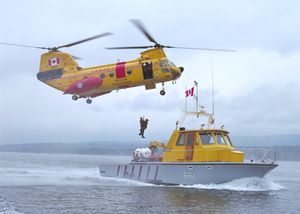
- CH-113 Labrador
- Search and rescue version of the Model 107-II-9 for the Canadian Forces Air Command. (18 built)
- CH-113A Voyageur
- Assault and utility transport version of the Model 107-II-9 for the Canadian Forces. (12 built)
Swedish Versions
- Hkp 4A
- Boeing Vertol 107-II, used originally by Air Force for SAR. (10),
- Hkp 4B
- Boeing Vertol 107-II-15, Navy (3)
- HKP 4C
- Kawasaki KV-107-II-16, Navy (8)
- HKP 4D
- Rebuilt Hkp 4A for SAR/ASW (Navy) (4)
Japanese Versions
- KV-107II-1 (CT58-110-1)
- Utility transport version.
- KV-107II-2 (CT58-110-1)
- Commercial airline version.
- KV-107IIA-2 (CT58-140-1)
- Improved version of the KV-107/II-2.
- KV-107II-3 (CT58-110-1)
- Minesweeping version for the JMSDF, 3 built.
- KV-107II-3A (CT58-IHI-10-M1)
- Uprated version of the KV-107/II-3.
- KV-107II-4 (CT58-IHI-110-1)
- Assault and utility transport version for the JGSDF.
- KV-107II-4A (CT58-IHI-140-1)
- Uprated version of the KV-107/II-4.
- KV-107II-5 (CT58-IHI-110-1)
- Long-range SAR version for the JASDF.
- KV-107II-5A (CT58-IHI-104-1)
- Uprated version of the KV-107II-5A.
- KV-107II-7 (CT58-110-1)
- VIP transport version.
- KV-107II-16
- HKP 4C for Swedish Navy. Powered by Rolls-Royce Gnome H.1200 turboshaft engines.
- KV-107IIA-17 (CT58-140-1)
- Long-range transport version for the Tokyo Metropolitan Police Department, 1 built.
- KV-107IIA-SM-1 (CT58-IHI-140-1M1)
- Firefighting helicopter for Saudi Arabia.
- KV-107IIA-SM-2 (CT58-IHI-140-1M1)
- Aeromedical and rescue helicopter for Saudi Arabia.
- KV-107IIA-SM-3 (CT58-IHI-140-1M1)
- VIP transport helicopter for Saudi Arabia.
- KV-107IIA-SM-4 (CT58-IHI-140-1M1)
- Air ambulance helicopter for Saudi Arabia.
Operators
Military Operators
Civilian Operators
- Helifor Canada Corp (under lease from Columbia Helicopters)
Former Operators
- Kawasaki Helicopter System, LTD
- Tokyo Metropolitan Police Department
Specifications (CH-46)
General characteristics
- Crew: 4: 2 pilots, 1 crew chief, 1 aerial gunner/observer
- Capacity: 25 troops
- Length: 45 ft 8 in fuselage (13.92 m
- Fuselage width: 7 ft 3 in (2.2 m))
- Rotor diameter: 51 ft (16 m)
- Height: 16 ft 8.5 in (5.1 m)
- Disc area: 4,100 ft² (380 m²)
- Empty weight: 15,537 lb (7,047 kg)
- Loaded weight: 17,396 lb (7,891 kg)
- Max takeoff weight: 24,300 lb (11,000 kg)
- Powerplant: 2× General Electric T58-GE-16 turboshafts, 1,870 shp (1,400 kW) each
Performance
- Maximum speed: 165 mph (143 kn; 265 km/h)
- Combat radius: 184 mi (160 nmi, 296 km)
- Ferry range: 420 mi (360 nmi, 676 km)
- Service ceiling: 14,000 ft (4,300 m)
- Rate of climb: 2,045 ft/min (10.4 m/s)
- Disc loading: 4.2 lb/ft² (21 kg/m²)
- Power/mass: 0.215 hp/lb (354 W/kg)
Armament
- Guns: 2× XM218 .50 BMG (12.7 x 99 mm) machine guns (optional), 1 Ramp mounted M240G 7.62 x 51 mm machine gun (optional)
See also
Related development
Comparable aircraft
Related lists
See also
Lists relating to aviation | |
|---|---|
| General | Timeline of aviation · Aircraft · Aircraft manufacturers · Aircraft engines · Aircraft engine manufacturers · Airports · Airlines |
| Military | Air forces · Aircraft weapons · Missiles · Unmanned aerial vehicles (UAVs) · Experimental aircraft |
| Notable incidents and accidents | Military aviation · Airliners · General aviation · Famous aviation-related deaths |
| Records | Flight airspeed record · Flight distance record · Flight altitude record · Flight endurance record · Most produced aircraft |
References
- ↑ Origins: Vertol V-107 & V-114, Vectorsite.net, July 1, 2004.
- ↑ 2.0 2.1 2.2 Spenser, Jay P. Whirlybirds, A History of the U.S. Helicopter Pioneers. University of Washington Press, 1998. ISBN 0-295-97699-3.
- ↑ 3.0 3.1 3.2 3.3 CH-46 history page, US Navy, 16 November 2000.
- ↑ 4.0 4.1 4.2 4.3 "Tandem Twosome", Vertical Magazine, February-March 2007
- ↑ CH-46 Sea Knight [H-49 "Phrog"]. Globalsecurity.org.
- ↑ 6.0 6.1 6.2 6.3 Boeing Sea Knight, Vectorsite.net, July 1, 2004.
- ↑ Boeing Vertol 107 - CH-46 Sea Knight. Helicopter History Site. Helis.com.
- ↑ Ask A Marine. HMM-364 Purple Foxy Ladies.
- ↑ Crawley, James W.. Swan song for Navy's ugly-duckling copter. SignonSanDiego.com.
- ↑ (2006). "Major Acquisition Programs - Aviation Combat Element Programs". Headquarters Marine Corps.
- ↑ White, LCpl Samuel. VMM-263 ready to write next chapter in Osprey program. U.S. Marine Corps.
- ↑ 12.0 12.1 Eichel, Garth, "Columbia Helicopters", Vertical Magazine, February-March 2007
- ↑ Type Certificate Data Sheet No. 1H16 (.pdf). Federal Aviation Administration (January 17,2007). Retrieved on Feb 8, 2007.
- ↑ Photo of Boeing Model 360 with CH-46X tail markings
- ↑ Boeing Model 360
- ↑ Royal Thai Army
- CH-46E Sea Knight Helicopter. HQMC Fact File. U.S. Marine Corps.
External links
- CH-46D/E Sea Knight and CH-46 history pages on U.S. Navy site; CH-46 page on USMC site
- CH-46 product page and CH-46 history page on Boeing.com
- Columbia Helicopters - Largest Civilian Operator of BV/KV Model 107
- Boeing Vertol 107 & H-46 Sea Knight on Airliners.net
- Kawasaki Vertol 107 on Airliners.net
Template:US Army helicopters Template:USAF helicopters Template:Boeing Vertol
cs:Boeing CH-46 Sea Knight de:Boeing-Vertol 107 es:Boeing CH-46 Sea Knight fr:Boeing-Vertol 107 it:Boeing CH-46 Sea Knight ms:CH-46 Sea Knight ja:V-107 pl:Boeing CH-46 Sea Knight pt:CH-46 Sea Knight ru:CH-46 Sea Knight fi:CH-46 Sea Knight sv:Hkp 4 tr:CH-46 Sea Knight
| This article is licensed under the GNU Free Documentation License. It uses material from the Wikipedia article "CH-46 Sea Knight". |
- Pages with broken file links
- Articles with unsourced statements since January 2008
- All articles with unsourced statements
- Active United States military aircraft
- Military helicopters
- United States military transport aircraft 1960-1969
- Vietnam War aircraft
- United States Marine Corps equipment
- Boeing aircraft
- Firefighting equipment
- Kawasaki aerospace
- Articles sourced originally from Wikipedia
